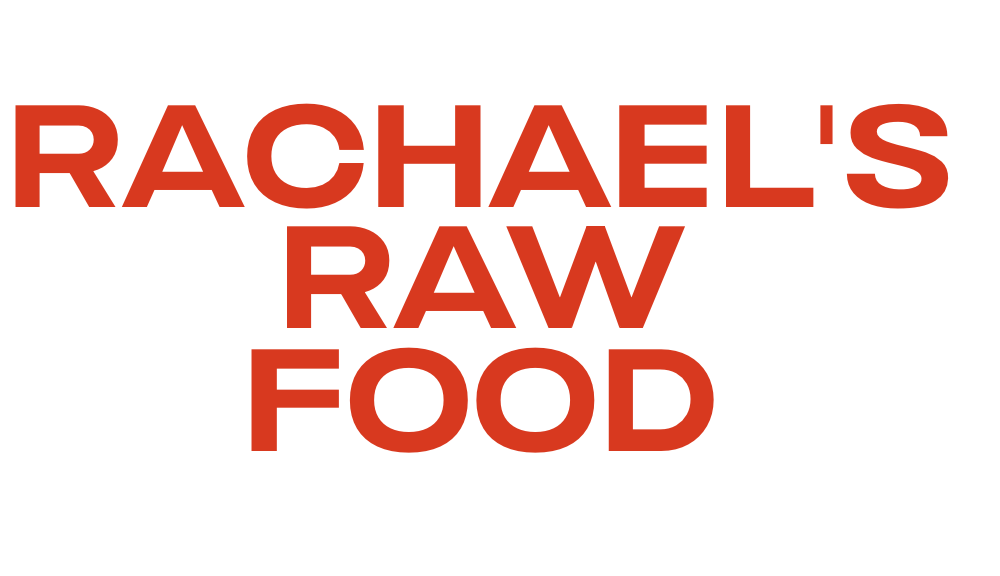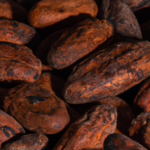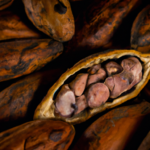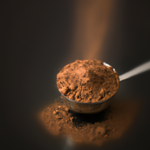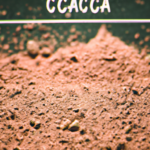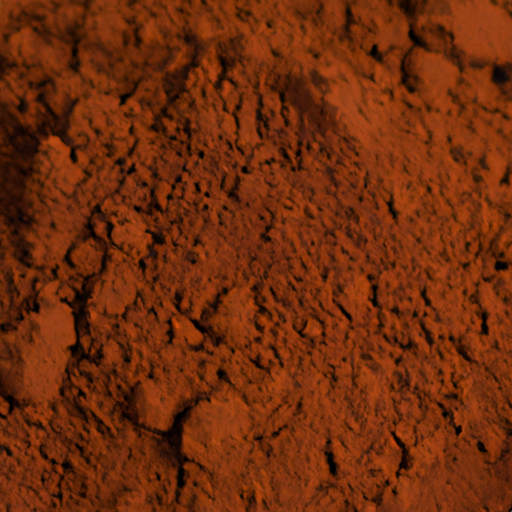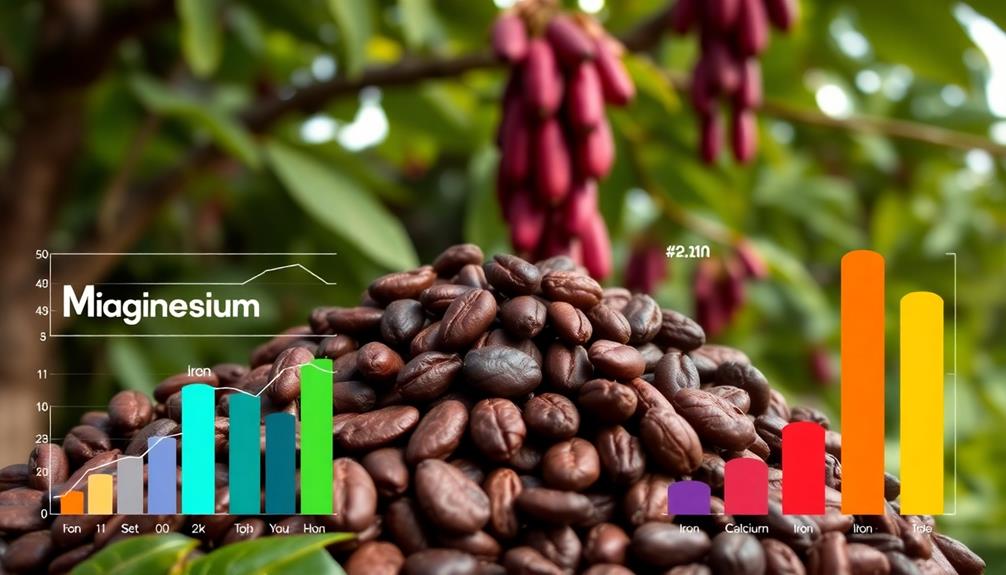Ever thought about the amount of raw cacao powder needed to feel its effects? Get ready for a ride as I delve into the realm of cacao and its psychoactive properties.
As a self-proclaimed chocoholic and curious individual, I’ve delved deep into the chemistry and effects of this delectable substance. In this article, we’ll explore the dosage needed to achieve a heightened state, the factors that can impact your sensitivity, and the potential health benefits (yes, there are some!).
But don’t worry, I’ll also shed light on the possible side effects and the ethical and legal considerations surrounding cacao consumption. Whether you’re a chocolate lover looking for a new way to experience bliss or just seeking some fascinating knowledge, this article will provide evidence-based insights to satisfy your craving for information.
So, grab your favorite mug and let’s dive into the world of raw cacao powder!
Key Takeaways
- Understanding dosage is crucial for a pleasurable experience with cacao powder.
- The potency of cacao compounds can vary, so start with a small amount and gradually increase dosage.
- Factors such as body weight, metabolism, and tolerance can affect sensitivity to cacao powder.
- Individual tolerance to cacao may vary, and body weight and metabolism can impact its effects.
The Chemistry of Cacao
The chemistry of cacao can transport you to a world of rich and indulgent flavors. Each bite sends waves of decadence through your taste buds.
The chemistry of fermentation plays a crucial role in developing the complex flavors of cacao. During fermentation, microorganisms break down the sugars in the cacao beans. This process produces various chemical compounds that contribute to the unique taste and aroma.
The chemical composition of cacao is responsible for its potential health benefits. Cacao is rich in antioxidants, specifically flavanols. These compounds have been linked to improved cardiovascular health and cognitive function.
Understanding the dosage of cacao is important to ensure a pleasurable experience without going overboard. Now, let’s delve into the next section to better understand how much raw cacao powder is needed to achieve a high.
Understanding Dosage
To truly understand dosages, it’s important to consider the potency and effects of the substance. When it comes to raw cacao powder, understanding its effects and proper measurement is crucial.
Raw cacao powder contains various compounds, such as theobromine and caffeine, which can have stimulating and mood-enhancing effects. The potency of these compounds can vary depending on the quality and processing of the cacao powder.
When determining the dosage, it’s essential to start with a small amount and gradually increase it to find the desired effect. Factors such as body weight, metabolism, and tolerance can also affect individual sensitivity to cacao.
By understanding the effects and proper measurement, one can safely and effectively consume raw cacao powder.
Now, let’s explore the factors that can influence sensitivity to cacao.
Factors Affecting Sensitivity
When it comes to understanding the factors affecting sensitivity to cacao powder, there are a few key points to consider.
First, individual tolerance plays a significant role, as some people may be more sensitive to the effects of cacao than others.
Second, body weight and metabolism can also influence how a person responds to cacao, as these factors can impact how quickly the body processes and absorbs the compounds in cacao.
Lastly, the quality and processing of the cacao powder itself can affect its potency and overall impact on the body.
It’s important to keep these factors in mind when considering the dosage of cacao powder to achieve desired effects.
Individual Tolerance
Although it may vary from person to person, it’s crucial to understand your own tolerance when it comes to consuming raw cacao powder for a potential high.
Each individual may have a different experience when consuming cacao powder due to factors such as body weight, metabolism, and overall sensitivity.
It is important to start with a lower dosage and gradually increase it until you find your desired level of effects. Pay attention to how your body reacts and adjust the dosage accordingly.
Keep in mind that individual tolerance can change over time, so what may have worked for you in the past may not have the same effect now.
Understanding your own limits and adjusting your dosage accordingly is the key to safely and responsibly consuming raw cacao powder.
Moving forward, let’s explore the impact of body weight and metabolism on cacao powder sensitivity.
Body Weight and Metabolism
Understanding your body weight and metabolism can have a significant impact on how you experience the effects of consuming raw cacao powder. Here are four key ways in which body weight and metabolism can influence the effects of cacao consumption:
-
Metabolic rate: Individuals with a faster metabolism may process cacao more quickly, resulting in a shorter duration of the effects.
-
Body composition: People with a higher percentage of lean muscle mass generally have a higher metabolic rate, which could potentially affect how cacao is metabolized.
-
Digestive efficiency: Variation in digestive enzymes and gut bacteria can influence the breakdown and absorption of cacao compounds, ultimately affecting its effects on the body.
-
Individual sensitivity: Those with a lower body weight may be more sensitive to the effects of cacao due to a higher concentration of consumed compounds.
Understanding these factors can help individuals personalize their cacao consumption for optimal enjoyment and potential health benefits.
Considering the impact of body weight and metabolism, let’s now explore the importance of cacao quality and processing.
Cacao Quality and Processing
In my previous discussion about body weight and metabolism, I explored how these factors can influence the effects of consuming raw cacao powder. Now, let’s delve into another crucial aspect – cacao quality and processing. The way cacao is cultivated and fermented can significantly impact its potency and psychoactive properties. Cacao cultivation involves the careful selection of cacao beans, which are then fermented to enhance their flavor and aroma. During the fermentation process, heat and microorganisms break down the beans’ complex compounds, resulting in the development of various bioactive substances. These substances, such as theobromine and phenethylamine, have the potential to affect our mood and cognition. Therefore, understanding the quality and processing of cacao is essential when considering its psychoactive effects. So, now that we have explored cacao quality and processing, let’s move on to the next section about preparing cacao for consumption.
Preparing Cacao for Consumption
To prepare cacao for consumption, you’ll need just the right amount of raw cacao powder to create a blissful and elevated experience. When it comes to preparing cacao beverages, finding the perfect balance is key. Start by experimenting with small amounts of cacao powder and gradually increase the quantity until you achieve your desired taste and effect. Traditional recipes often call for specific measurements, but personal preference plays a significant role in determining the ideal amount.
To evoke a sense of warmth and comfort, imagine sipping a steaming cup of hot chocolate on a cold winter’s day. The rich aroma and velvety texture of cacao can transport you to a place of relaxation and indulgence. Alternatively, envision adding a sprinkle of cacao powder to your morning smoothie, infusing it with a subtle hint of bitterness and earthiness. Lastly, picture yourself biting into a decadent piece of chocolate cake, the cacao creating a deep, intense flavor that lingers on your palate.
Preparing cacao for consumption can be a truly transformative experience, awakening your senses and tantalizing your taste buds. Now, let’s explore the potential health benefits that cacao has to offer.
Potential Health Benefits
When it comes to the potential health benefits of cacao, there are several key points to consider.
First, cacao is known for its antioxidant properties, which can help protect our cells from damage caused by free radicals.
Second, consuming cacao has been linked to mood enhancement, as it contains compounds that can boost serotonin levels in the brain.
Lastly, cacao has been shown to have positive effects on cardiovascular health, such as lowering blood pressure and improving blood flow.
Overall, incorporating cacao into our diet can have a range of potential health benefits.
Antioxidant Properties
Moderation is key when consuming raw cacao powder to experience its antioxidant properties. Research has shown that cacao is rich in antioxidants, which can help fight free radicals and reduce oxidative stress in the body.
These antioxidants have been found to have positive effects on skin health, improving its elasticity and reducing the signs of aging. Cacao also contains flavonoids, which have been linked to a lower risk of heart disease and improved brain function.
However, it is important to note that these benefits are best achieved through moderate consumption. Excessive intake of raw cacao powder may lead to negative effects such as digestive issues or an imbalance in mineral levels.
Transitioning into the next section, cacao also has mood-enhancing properties that we will explore further.
Mood Enhancement
Indulging in a small amount of cacao can lift your spirits and bring a delightful sense of joy to your day. Cacao contains several compounds that can enhance your mood naturally.
One such compound is phenylethylamine, which stimulates the release of endorphins and boosts feelings of happiness and well-being.
Another compound, anandamide, acts on the brain’s pleasure centers, promoting a sense of bliss and relaxation.
Additionally, cacao is rich in flavonoids, which have been shown to reduce symptoms of depression and anxiety. These natural remedies in cacao can have a positive impact on enhancing well-being.
Moving on to cardiovascular health, consuming cacao in moderation has been linked to improved heart health and reduced risk of heart disease.
Cardiovascular Health
Cacao’s positive impact on cardiovascular health has been linked to improved heart health and a reduced risk of heart disease. Studies have shown that the consumption of cacao can contribute to cardiovascular disease prevention by managing blood pressure levels.
The high content of flavonoids, particularly flavanols, found in cacao has been associated with lower blood pressure and improved blood flow. Flavanols help relax and widen blood vessels, which in turn reduces the strain on the heart and promotes healthy blood circulation.
Additionally, cacao has been shown to have antioxidant properties that can protect against the development of atherosclerosis, a condition characterized by the build-up of plaque in the arteries. These findings suggest that incorporating cacao into a balanced diet may have a positive impact on cardiovascular health.
Moving forward, it is important to consider possible side effects associated with excessive cacao consumption.
Possible Side Effects
Be cautious about consuming excessive amounts of raw cacao powder as it may have potential side effects that could affect your well-being. While cacao powder is generally safe when consumed in moderation, consuming large doses can lead to negative effects. Some potential long-term effects of excessive cacao consumption include an increased risk of kidney stones due to the high oxalate content and potential weight gain due to its calorie density. Additionally, cacao powder can interact with certain medications, such as MAO inhibitors, antidepressants, and stimulants, leading to adverse effects. It is important to consult with a healthcare professional if you are taking any medications to ensure there are no potential drug interactions. In the next section, we will explore the topic of combining cacao with other substances.
Combining Cacao with Other Substances
When you mix cacao with other substances, it’s like adding fuel to a fire, intensifying the effects and potentially leading to an overwhelming experience. Cacao itself is already a stimulant due to its high levels of theobromine and caffeine.
When combined with alcohol, which is a depressant, the effects of both substances can be amplified, resulting in a more pronounced intoxication. This combination can also increase the risk of experiencing negative side effects such as nausea, dizziness, and even heart palpitations.
It’s important to note that the effects of mixing cacao with alcohol can vary depending on individual factors such as metabolism and tolerance. Therefore, it is crucial to exercise caution and moderation when combining these substances.
Moving forward, it is essential to consider the legal and ethical considerations surrounding the use of cacao as a recreational substance.
Legal and Ethical Considerations
When it comes to combining cacao with other substances, it is essential to consider the legal and ethical implications.
One aspect to consider is the ethical sourcing of cacao. The demand for cacao has led to concerns over child labor and exploitative working conditions in some regions. Therefore, it is crucial to support companies that prioritize fair trade and ethical practices.
Additionally, the environmental impact of cacao production should be taken into account. Unsustainable farming methods can lead to deforestation and the loss of biodiversity. By choosing cacao products from companies that practice sustainable farming techniques, we can help reduce the environmental impact.
These considerations ensure that our consumption of cacao aligns with our values and contributes to a healthier planet.
Now, let’s explore alternative options for achieving a desired high without relying solely on cacao.
Exploring Alternative Options
To explore alternative options for achieving a desired high, you can try experimenting with various herbs and plants that have mind-altering effects.
While raw cacao powder may not be the best choice for getting high, there are other natural substances that can produce similar effects.
For example, some people have reported using herbs like kratom or kava to achieve a euphoric and relaxing state. These substances have been used for centuries in traditional medicine and are known to have psychoactive properties.
However, it is important to note that alternative methods come with potential risks. The effects of these herbs can vary from person to person, and there is limited scientific research on their long-term effects or interactions with other medications.
It is crucial to approach these alternative options with caution and consult with a healthcare professional before experimenting.
Frequently Asked Questions
Can cacao powder get you high?
Raw cacao powder does not have psychoactive properties and cannot get you high. However, it has numerous benefits, such as being rich in antioxidants, minerals, and polyphenols. It differs from cocoa powder in terms of processing and nutrient content.
How much cacao powder should I consume to experience a psychoactive effect?
To experience a psychoactive effect from cacao powder, it is important to consider the dosage. While there are compounds in cacao that can have mood-enhancing effects, the amount needed to achieve a noticeable high is significantly higher than what is typically consumed.
What are the potential long-term health risks associated with consuming high doses of cacao powder?
Potential health risks associated with consuming high doses of cacao powder include digestive issues, increased heart rate, and caffeine-related symptoms. Long-term effects may include nutrient imbalances, weight gain, and the potential for addiction or dependence.
Can combining cacao powder with certain substances enhance its psychoactive effects?
Combining cacao powder with cannabis can potentially enhance its mood-enhancing effects. While evidence is limited, some users claim that the combination can lead to a more pronounced psychoactive experience.
Are there any legal restrictions or ethical concerns surrounding the use of cacao powder for recreational purposes?
Legal restrictions and ethical concerns exist regarding the recreational use of cacao powder. Regulations vary by jurisdiction, with some countries prohibiting its use due to the potential for misuse or confusion with illicit substances.
Is Eating Raw Cacao Powder the Same as Consuming Raw Cacao?
Eating raw cacao powder is not the same as consuming raw cacao in its natural form. Raw cacao powder is processed, which may alter its nutritional content. To avoid exceeding the raw cacao consumption limit, it’s essential to be mindful of portion sizes when incorporating it into your diet.
Conclusion
In conclusion, consuming raw cacao powder in order to get high is not recommended. While cacao does contain certain compounds that can affect our mood and stimulate the release of endorphins, it is unlikely to produce a significant psychoactive effect.
Additionally, the dosage required to achieve a high is uncertain and can vary depending on factors such as sensitivity and preparation methods.
It is important to prioritize the potential health benefits of cacao and use it in moderation as part of a balanced diet.
